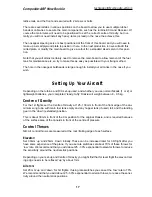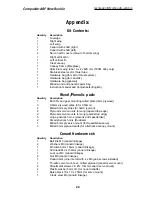
Rudders:
It is not possible to get a lot of throw on the rudders, and they are not terribly effective anyway,
although enough for ‘knife-edge’ flight - so just set the throws to the maximum you can get, which
is about 20mm (3/4”) each way. They are useful for take-off in cross-winds, because there is not
much weight on the nosewheel, and of course in some countries working rudders are mandato-
ry because of the law.
Speedbrake:
Set the travel to give you at least 80 degrees, and 85° or 90° if possible, to get the maximum
braking effect for landing. The (optional) speedbrake gives very little pitch-up effect, and you
will probably not need any elevator mixing with it.
Canards:
The Canards have to be mixed with the elevator function of the elevons so that the trailing edge
of the canard goes ‘down’ when the trailing edge of the elevator/elevon goes ‘up’, and vice versa.
For first flights we recommend that you limit the canard throw to 15 - 20mm ‘down’ and 10 -
15mm ‘up’.
After you have some experience you can increase the throws to 25mm ‘down’ and 25 mm ‘up’.
You can also use the Canards as a ‘speedbrake’ for landings, instead of the speedbrake under
the fuselage. Set them on a separate ‘landing mode’, or switch, so that the trailing edge deflects
75 - 80 degrees ‘up’ which gives a very powerful speedbrake effect for landing. Of course you
must
not
use a slow travel for this - it needs to move to this position very quickly. Slow the plane
down to ‘landing circuit speed’ before applying. You will get a ‘pitch up’ effect for a couple of sec-
onds, and then the plane settles back into almost horizontal flight, so you will not need any ‘down
elevator’ mixed in. Use throttle to maintain your required angle of descent. Unless you are using
a powerful turbine with a lot of residual thrust at idle, you will
no
t need to combine this with the
speedbrake under the fuselage, which can be switched off. If you want to use this option you will
probably need a longer servo arm to get the throw needed.
With experience you will find that you can perform some amazing manoeuvres using the canards
and increased throws, mixed in with the Thrust vectoring, but we strongly recommend that you
take care when using combined vector thrust and canards at high speed as the forces on the air-
frame are enormous.
Thrust Vectoring:
Set the throw for as much movement as possible, and add about 50% reverse exponential, so
that with 50% stick movement for the elevator function you already have 100% vector thrust noz-
zle deflection for the maximum effect.
Make sure that you can switch ‘off’ the thrust vectoring system for high speed flight, above about
120mph (190kmh), because it is so powerful that you could fold the wings - especially when
combined with the canards.
Warning
The ‘New Rookie’ is quite fast when powered with a turbine with a thrust of 8 - 12 kg, which is
the maximum recommended. Of course the speed at which you fly it is up to your skills and expe-
rience, but we highly recommend that you use a speed limiter to prevent exceeding 220 mph
(350 Kmh). With care you can use the Vector thrust and the Canards together at high speed, but
we recommend that you use a 70% low rate for the canard throws if you are going to do this, as
Composite-ARF New Rookie
18






































